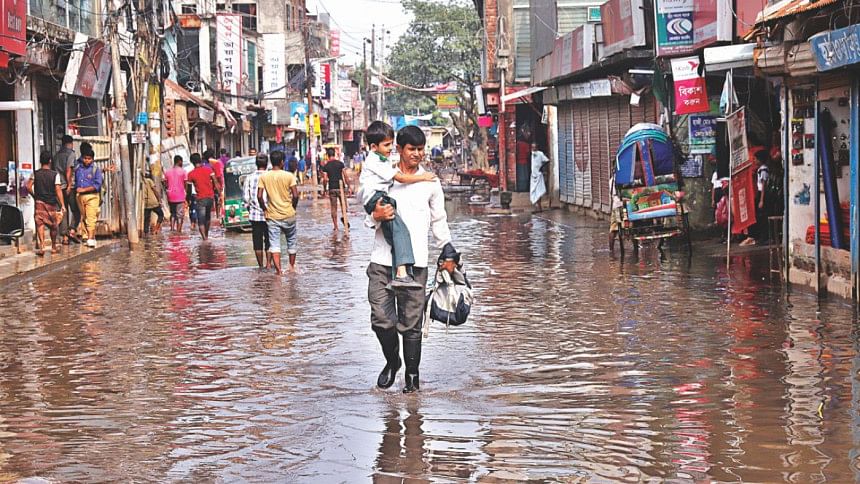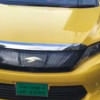The inequality of Dhaka's roads

The waterlogging problem in the capital is never more evident than now. A morning's rain floods roads, stretches of major thoroughfares and even homes. It also compounds traffic jams. Where there isn't adequate drainage, waters rise, inundating roads and pavements, suspending regular mobility in the city, as seen in the city last weekend.
Over the last two years, Dhaka North City Corporation took the initiative to improve drainage in Banani-Gulshan-Baridhara, otherwise known as the tri-state area in local lexicon. The inner roads of Gulshan-1, after more than a year of remaining perennially dug up, are finally passable. The roads are smooth, with yellow lines streaking through the middle, and bordered with red and yellow footpaths. Up to earlier this year, there were giant pipes strewn about.
The priority, says Project Director Md Sharif Uddin, was to prevent waterlogging. “The tri-state area had no drainage network, with runoff rushing to the lake leading to overflow and pollution,” he explains. By installing a storm drainage system, roads and footpaths would also be improved as damage during the monsoon would be minimised.
"The DNCC claims that footpaths (not just in the tri-state area but in other areas of Dhaka North) are being made to a standard but this standard is not evident in the rest of Dhaka North as of yet.
The Tk 200-crore project to install 25 km of pipeline and improve roads and footpaths in the area took place over the last two years. “About 80 percent of the roadworks have been implemented successfully,” says Md. Mesbahul Islam, Chief Executive Officer of DNCC.
He adds that their goal has been to make all roads in DNCC areas passable in the short-term.
But are all roads treated equally by them? Why was the initiative to improve roads, footpaths and drains in the upscale tri-state area prioritised by the incumbent Mayor and the DNCC in their first two years in office?
Gulshan-2 circle has been painted and pedestrian crossing paths are marked on all the roads leading to it. Sitting in the opulent offices of the DNCC near the circle, the view is impressive. With the large yellow crisscrossed square in the centre and high-rise buildings all around, it looks not unlike a major city square.
Though the initiative is commendable, was DNCC only willing to give this much effort because this was the tri-state area?
Their answer is yes. Embassies, homes of top government officials and diplomats, and the offices of international organisations are located here. “Improving roads and footpaths here was paramount because the country is represented by this area,” argues project director, Sharif Uddin.
The DNCC claims that footpaths (not just in the tri-state area but in other areas of Dhaka North) are being made to a standard but this standard is not evident in the rest of Dhaka North as of yet.

Selective development in Dhaka North?
The question of selective development works is not new. In a meeting with editors and prominent journalists earlier this year, Mayor Annisul Huq was criticised for prioritising development schemes in upscale areas of DNCC in the two years he's been in office.
Looking over this year's (2016-2017) budget revealed such discrepancies. The tri-state area constitutes almost seven sq km, roughly one-twelfth of DNCC's existing jurisdiction. But where Tk 88.20 crore was allotted to repair various damaged roads, drains and footpaths in Dhaka North as a whole, Tk 65 crore was allocated separately for the same purpose in the tri-state area alone. The tri-state area got more money than its size would account for.
Uttara, being similarly-sized to the tri-state area (an area of over six sq km), got around half its budget. The imbalance is even more pronounced in the proposed budget for 2017-2018. Uttara is being given Tk 16.5 crore, less than one-quarter of the tri-state's Tk 66.6 crore allocation.
Gulshan and Baridhara are hardly the first places to come to mind when envisioning waterlogging and pothole-ridden roads. You think of Khilgaon or Mirpur. Or the stretch of road from Bashundhara residential area to Malibagh via Badda and Rampura.
"DNCC may install drainage networks but other organisations, including Dhaka Water Supply and Sewerage Authority (Wasa), are responsible for maintenance. Though inequality in Dhaka's roads are something the DNCC says they are addressing, it remains to be seen whether others choose to address it.
Rampura road, an important thoroughfare, is notorious for massive potholes and a dust fog that hangs in the air. Buses almost tilt over on that road because of the giant potholes, their passengers lurching in the wake. Giant portions of the road are dug up. It lies on the other side of Hatirjheel, not far from the spick and span roads of Gulshan.
M N Jahangir Bashri, a retired tax collector, is currently a resident of Merul Badda. “The inner roads of Badda are in a terrible state,” he says. Before this, Bashri lived nearby in Banasree. The main road in Banasree, which falls under DNCC, is similarly affected with vehicles facing a hard time on the roads, let alone pedestrians. “It once took my son and daughter-in-law an entire hour to pass that stretch of the road to exit Banasree,” says Bashri.
“These two years have been difficult; in both areas I resided in, the state of the roads are terrible and show no results,” adds Bashri. Roadworks happen year-round, but offer little relief to residents in areas where they are needed the most.
In an interview to The Daily Star in May this year, Mayor Annisul Huq proclaimed, “By the end of 2018, there will hardly be any dilapidated roads, footpaths and drains.” This sentiment is echoed by Sharif Uddin, also superintending engineer for the entire DNCC. “You will see a drastic improvement [like seen in the tri-state area] by this December,” he promises.
Improvements withstanding, jurisdiction remains a problem. DNCC may install drainage networks but other organisations, including Dhaka Water Supply and Sewerage Authority (Wasa), are responsible for maintenance. Though inequality in Dhaka's roads are something the DNCC says they are addressing, it remains to be seen whether others choose to address it. It also remains to be seen whether the repairs and new infrastructure hold up under the relentless stress of Dhaka city or whether they're just another facelift, especially for upscale areas.








Comments